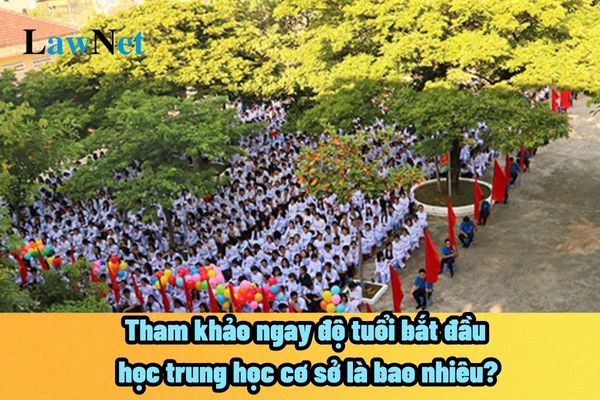Vietnam: At what age do students begin lower secondary education?
At what age do students begin lower secondary education?
According to Article 28 of the Education Law 2019 of Vietnam, educational levels and entry ages are as follows:
Educational levels and entry ages
1. Educational levels and age groups of general education are regulated as follows:
a) Primary education lasts for 05 school years, from the first to the fifth grade. The entry age for the first grade is 06;
b) Lower secondary education lasts for 04 school years, from the sixth to the ninth grade. Students must complete the primary educational programme before entering the sixth grade. The entry age for the sixth grade is 11;
c) Upper secondary education lasts for 03 school years, from the tenth to the twelfth grade. Students must complete the lower secondary educational programme before entering the tenth grade. The entry age for the tenth grade is 15;
...
Lower secondary education is carried out over 4 academic years, from grade six to the end of grade nine. Students entering grade six must have completed the primary education curriculum. The age of students entering grade six is 11 years old and is calculated by the year;
Thus, it can be seen that the starting age for entering lower secondary school is generally 11 years old.

Starting age for entering lower secondary school (Image from Internet)
Do lower secondary school students with an average conduct grade have the opportunity to move up to the next grade?
According to the new regulations in Circular 22/2021/TT-BGDDT of the Ministry of Education and Training of Vietnam, students are no longer categorized by conduct grades. Instead, their performance results will be evaluated.
According to Article 12 of Circular 22/2021/TT-BGDDT, regulations on grade advancement, re-assessment during summer break, and grade retention are as follows:
Grade advancement, re-assessment during summer break, and grade retention
1. A student who meets following eligibility may advance to the next grade or be recognized as to have completed lower education program or upper education program:
a) Training results of the entire school year (including re-assessment results after training during summer break according to Article 13 hereof) are Qualified or higher.
b) Learning results of the entire school year (including re-assessment results of all subjects according to Article 14 hereof) is Qualified or higher.
c) Number of days leave does not exceed 45 half-days (calculated according to education plans which is 1 half-day for every day under formal education plan, including permitted leave, unpermitted leave, continuous leave, and intermittent leave).
2. In case a student must undergo training during summer break, comply with Article 13 hereof; students must attend re-examination or re-assessment of subjects during summer break as per Article 14 hereof.
3. A student who does not meet all eligibility under Clause 1 of this Article are not allowed to advance to the next grade or recognized as to have completed lower secondary education level or upper secondary education level.
4. For students with disabilities: Principals shall rely on assessment results of students with disabilities as per Article 11 hereof to consider grade advancement or recognition of completion of lower secondary education level or upper secondary education level.
Students who meet the following conditions will advance to the next grade or be recognized for completing the lower secondary education program:
(1) The annual conduct result (including re-evaluation result after training during the summer break as stipulated in Article 13 of Circular 22/2021/TT-BGDDT) is rated as "Satisfactory" or higher.
(2) The annual academic result (including re-evaluation result of subjects as stipulated in Article 14 of Circular 22/2021/TT-BGDDT) is rated as "Satisfactory" or higher.
(3) Absences do not exceed 45 days in an academic year (calculated based on the educational plan of 1 session per day as stipulated in the General Education Program, including absences with and without permission, continuous or non-continuous absences).
Thus, according to the regulation, if lower secondary school students are rated "Satisfactory" in conduct and meet other conditions, they will be considered for advancement to the next grade.
What does the re-enrollment application procedure for lower secondary school students who have previously dropped out include?
According to Article 6 of the Regulation on school transfers and re-enrollment for students at lower secondary and upper secondary schools issued together with Decision 51/2002/QD-BGDDT of the Ministry of Education and Training of Vietnam, the re-enrollment application and procedure are as follows:
(1) Re-enrollment Application.
+ Re-enrollment application form signed by the student.
+ The original academic record of the grade or education level previously completed.
+ A notarized copy of the lower-level graduation certificate.
+ Confirmation from the local government where the student resides regarding compliance with state policies and laws.
(2) Re-enrollment Procedure.
+ For re-enrollment at the previous school:
The school principal permits re-enrollment after verifying the application.
+ For re-enrollment at a different school:
Supplement the application and follow the procedure for school transfers.
+ For re-enrollment into the starting grade of upper secondary school:
The Director of the Department of Education and Training will consider and decide based on the student's previous entrance exam or admission result before dropping out.
(3) Re-enrollment is conducted during the summer before the new academic year begins.
In addition, based on paragraph 1 Article 28 of the Education Law 2019, which stipulates the levels of education and ages for general education, if re-enrollment falls within the stipulated age for each education level, the student will continue their education.
If the age exceeds the stipulated limit for the education level, re-enrollment is not permitted due to age restrictions within the education level (stipulated in paragraph 2 Article 4 of the Regulation issued together with Decision 51/2002/QD-BGDDT, which states that re-enrollment applies to students who re-enroll after a period of absence but remain within the stipulated age for each education level).

